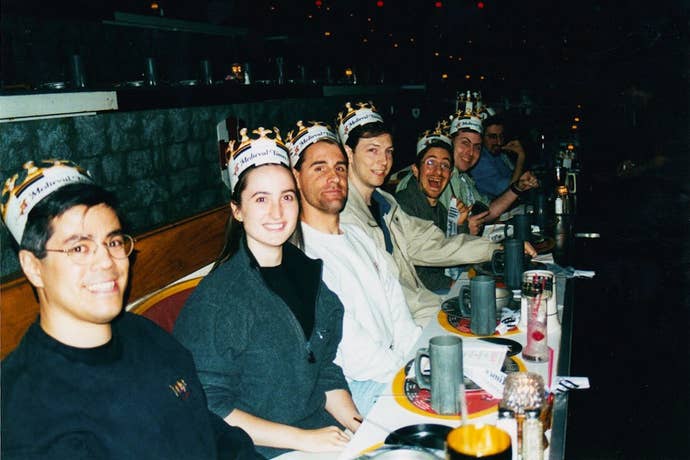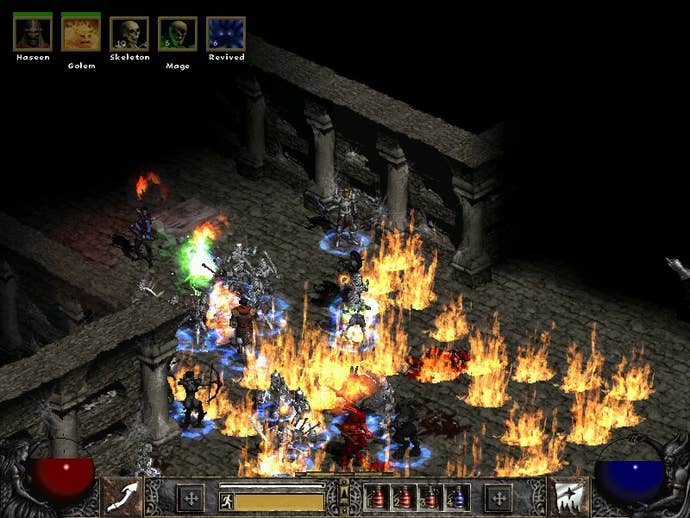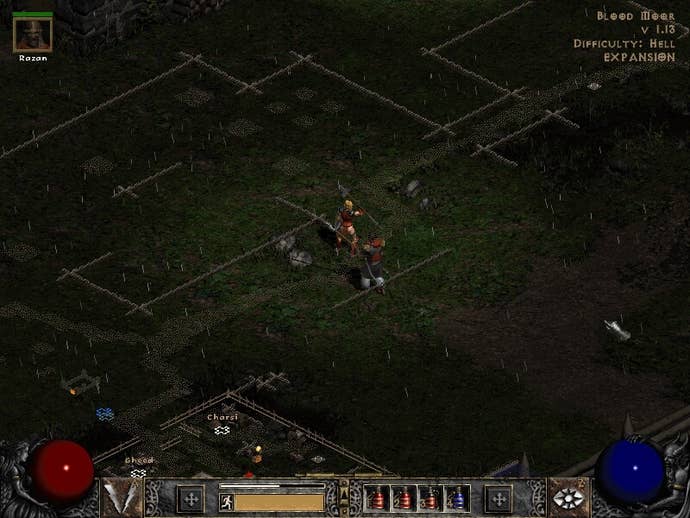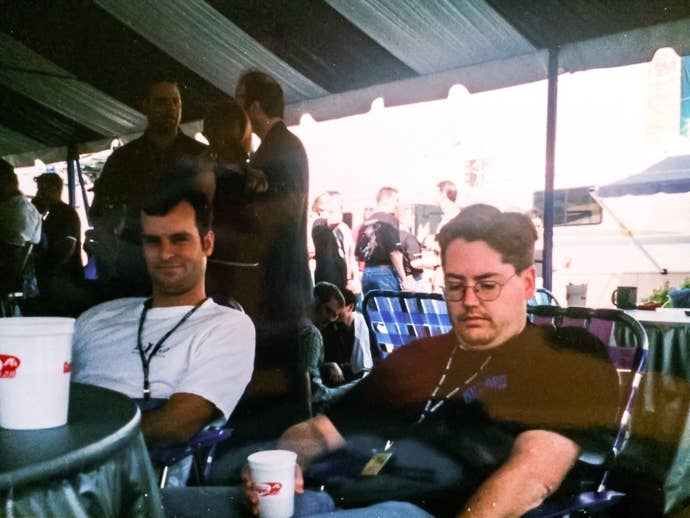Designing Diablo 2: Building Blizzard's Iconic World
In an excerpt of a chapter from the second installment of the Stay Awhile and Listen series, designers from Blizzard talk about the formation of some of Diablo 2's defining characteristics.
This article first appeared on USgamer, a partner publication of VG247. Some content, such as this article, has been migrated to VG247 for posterity after USgamer's closure - but it has not been edited or further vetted by the VG247 team.
The following is an excerpt from a near-complete edition of Stay Awhile and Listen: Book II – Heaven, Hell, and Secret Cow Levels, now funding in ebook and paperback formats on Kickstarter. Stay Awhile and Listen: Book II chronicles the making of StarCraft and Diablo II, and reveals never-before-known details about cancelled projects and the history of Blizzard Entertainment and Blizzard North.
Chapter 8: A Business-Like Approach to Showers
If you could show the initiative and bust your butt and come up with something? Hell yeah, it went in. —Ben Boos, artist, Blizzard North
One of the most awesome things about skill trees is that they show the player how he can grow his avatar, what his avatar is capable of becoming at the highest levels, right from the beginning of the game. —Stieg Hedlund, designer, Blizzard North
At some point, people started joking, "Oh, no, don't tell me he took a shower this morning." I'd come up to people's desks first thing in the morning, and they'd say, "Oh, no. Okay, I'm ready: What did you think of?" —David Brevik, co-founder, Blizzard North
The biggest game company I had seen so far had been Origin. They had their own building with offices on multiple floors, a cafeteria. When you walked inside, there was a receptionist, there were TV monitors, they had a gift store. They looked like they had their act together. Blizzard North was nothing like that. —Philip "Phil" Shenk, artist, Blizzard North

From Tristram's dusky lighting to the bone-wrought walls and ash-covered floors of hell, Diablo's critical and commercial success was due to the personalities of its small team. Every developer at Blizzard North had touched it. Their fingerprints could be found on every monster, every spell, every procedurally generated item, every step of the doomed player-character's journey down into darkness. The trials players faced on that journey were arduous, but the mechanics of that journey were the exact opposite.
Click to move. Click to attack. Click to pick up items.
Simplicity formed the dark heart of Diablo. That vital organ would be transplanted into Diablo II. Every other organ—monsters, environments, heroes, loot—would be rebuilt from the ground up. "There was a list of characters and capabilities that we knew we wanted in the game, so the systems were designed to try to be capable of those features," said Steven Woo, programmer at Blizzard North. "A lot of times the artists, programmers, and designers would have discussions about whatever feature they think needed to be done, and just make it happen."
Diablo's hero classes sat near the top of the team's must-fix list, second only to the rampant cheating that had tarnished the game's online experience. Over several months, the team settled on five classes. The Amazon, a muscular, female fighter, was the first. "The character team decided they wanted to work on a hot chick first, and that's what they did," explained David Brevik.
The Amazon did not start out as a "hot chick." Kris Renkewitz, the hero's original artist, sketched a tall, fearsome woman who wore bracers that coiled down her arms, animal-skin boots, and mummy-like wrappings that covered her most intimate parts, leaving the rest of her skin exposed. Her hair was short and spiky, her visage grim and feral. "I designed the character to be, well, like an amazon," Kris said. "She was a giant chick. Her helmet looked different, her armor looked different, her weapons were weird. It wasn't just a girl with a pony tail and wearing leather," he added, referring to the hero's completed form.
Dave, Max, Erich, and Stieg decided a Xena-type appearance was too wild for their tastes. One of Blizzard North's newest artists, who joined the company in August 1997, took a crack at her revisions. "You know what it felt like?" reminisced Phil Shenk of his time at Blizzard North. "Like you were making games with the kids who played Dungeons & Dragons in their basement. It felt like we were in the basement with all these cool tools, just making up weird, arcane stuff."
Phil got his start in the industry creating graphics for pinball games—most notably the Space Cadet table of Full Tilt!, packaged into every version of Windows beginning with Microsoft's Windows 95 Plus! add-on pack and ending with Windows XP—at Cinematronics, a studio based in Austin, Texas, and acquired by SimCity developer Maxis. Champing at the bit to draw something besides flippers and springs, Phil taught himself 3D Studio Max and partnered with two other designers to make Crucible, an action-roleplaying game and one of the motivators behind Maxis's decision to acquire the studio in 1996.
At E3 in June 1997, Crucible caught the eye of Matt Householder, who passed out business cards to the developers on hand to demo the game. Phil filed the card away. He was optimistic about Crucible's prospects. That same month, Electronic Arts purchased Maxis in a stock swap for $125 million and announced plans to shutter Cinematronics and relocate the team from Austin to Silicon Valley, where they would work on SimCity games. Uninterested in modeling roads and buildings, and aware that Crucible still had a long way to go, Phil dug out Householder's card. "We didn't know what we were doing," he admitted of his action-RPG project. "We probably couldn't have made that [persistent] multiplayer game. We hadn't even started the multiplayer component."
On the day of his interview, Phil entered the hallowed halls where Diablo had been made and needed a beat to digest reality. Water dribbled from dark stains on the ceiling. The carpet below them stank of mildew. Fans spread the stench more effectively than they dried puddles. Equipment had been piled atop desks so computers, keyboards, speakers, and drawing tablets wouldn't get wet. Stacks of cubicles formed barriers in hallways. "It looked like a fly-by-night operation, but it was busy," he said. "It was bustling. Everybody was active. It was energetic. But it wasn't at all what I'd thought it would be. It didn't come across as a well-oiled machine. It came across as a bunch of guys who'd just bought some office space and were just moving full-steam ahead."
He landed the job and showed up on his first day ready to dig in. Pulling up the most recent prototype of Diablo II, Phil's enthusiasm gave way to concern. The prototype was barebones, consisting of a single, tiny dungeon built from gray tiles. The game ran at 640x480. Phil was surprised Blizzard North wasn't pushing to hit 800x600, the next resolution up. What really stood out to him was the Amazon. She moved in slow, floaty lurches, as if wading through water, and she was too fearsome for Phil's tastes. Firing up 3D Studio Max, he overhauled the hero into a bombshell: Still tall, fierce, and powerful, but with long golden hair pulled back into a ponytail, and a busty chest and curvaceous figure that filled out skintight leather armor.
When the rest of the guys exclaimed over his design, Phil breathed a sigh of relief. He had worried that any team capable of designing a game as brilliant as Diablo would reject ideas from the lowest members on the company's totem pole. Over time, his first impression of Blizzard North's somewhat grungy environment changed. No way could a game as inventive, dark, and quirky as Diablo been invented in a clean, sterile office. "I figured Diablo was the epitome of conscious art direction: Everything was planned out. Tristram had this sort of strange, gray, stormy color scheme to it," he said. "It wasn't day, it wasn't night. And I was thinking, How did they come up with that? It's not night, but it doesn't feel like daytime. It felt kind of like an in-between world. I thought those guys were geniuses. But certainly as I got to know them, I discovered that it all kind of happened by the seat of their pants."

While the amazon's gender was locked to female, players would be able to alter her appearance by equipping armor purchased from vendors or pried from the cold, dead hands of monsters. This, too, was a system carried over from Diablo. In the first game, player-characters were rendered on-screen in light, medium, or heavy armor depending on the category of the equipment they put on. Limiting on-screen depictions to one of three appearances had lightened the load of artwork carried by Blizzard North's upstart team, but also cut back on style. A Warrior in rags looked the same as another Warrior sporting leather armor studded with spikes, since both armor types fell into the "light" category.
There were other limitations. Gear such as helms, swords, and shields were also depicted based on the category of body armor, so a short sword appeared chipped and unadorned while held by a character wearing light gear, only to become more ornate when the player dressed in chainmail (medium) or plated mail (heavy). The team's decision to limit renditions of player-characters to three visual styles had likewise been born of resources. At the time Diablo had got off the ground, Blizzard North—then Condor—had operated on a shoestring budget with a small team of untrained yet scrappy artists. They simply could not afford to reflect every individual ring, amulet, sword, axe, club, and piece of armor that players wore.
Thanks to the studio's success, Diablo II's artistic reservoir ran much deeper than its predecessor's. "We started thinking about how to put together the characters as a paper doll," Kris Renkewitz explained.
"Characters were rendered kind of like G.I. Joe figures, so you could tear them apart: right arm, left arm, right leg, left leg, torso, then individual hands," added Robert Steele, one of the game's character artists.
Diablo II's paper-doll system was spearheaded by Jon Morin. Still disappointed that the voxel engine he had been developing with Dave Brevik and Doron Gartner had been a bust, he was on the lookout for ways to contribute. When a rendering system that worked like paper dolls was floated in a meeting, Jon volunteered to code it up. Working with Phil Shenk, he wrote a tool that enabled artists to model specific body parts. Moreover, each hand could hold a different weapon, and any number of components could be mixed and matched. "I ended up writing the module system that sorted all the pieces, so that when you put on this particular sword and that particular armor, it would look almost exactly like them when portrayed on your character," he explained.
Jon and Phil tested their component system on a monster, an easier testbed than a player-character since the pool of gear for heroes would be much deeper. For the system's first outing, they decked out a corrupt rogue, an undead Rogue hero from Diablo. "I believe the corrupt rogues were the only monsters that were componentized as fully as the [heroes]," said Phil Shenk. "They could hold every weapon type, I believe. All the other monsters were more piecemeal just to provide variety. If anything had a weapon, the weapon would be a component. There was a head, a torso, a left arm, a right arm, a left hand, a right hand, legs, shoulder pads."

The extent of a character's customization depended on need. Fallen, the skittish, goblin-like agitators from Diablo that picked fights only to flee when their comrades fell around them, could be armed with various weapons and head pieces, as could skeletons. Their character models were simple: bone arms for skeleton, single-color arms for different types of fallen. By mixing and matching arms and the weapons they held, the artists could effectively create multiple types of each monster.
On the flip side, fewer paper-doll options streamlined the painstaking order of operations when rendering characters for the game. Every character was loaded into a rendering queue. Because every hero could face sixteen directions, an artist had to render every attack animation for each possible direction. Monsters, which could only face eight directions, were easier, but only relatively. Building out any character was an immense task. "We had a tool that helped us sort all the different body parts at every different angle so that, say, frame-5 displayed correctly, and to make sure the left arm wasn't behind the torso," said Anthony Rivero. "It was a pain in the ass to do that. You had to make sure all that stuff was sorted in the proper order."
"You'd make these render queues, and there'd be maybe 500 things in a render queue," Kelly Johnson added. "Just making that render queue took an hour or two."
"Because we had to do the whole component system of different body parts, sometimes their order would get screwed up," Pattie Tougas added. "So, you'd have a head for a leg, a torso for the arm, an arm for the body. And you could walk around like that."
Armed to the teeth, the Amazon and Diablo II's growing bestiary were in need of a field of battle. The game would feature derelict chambers and gloomy hallways, but in a twist, would not be the most common type of terrain. Blizzard North's breakout game had been vertical: Start on the surface and venture down, down, down through a stack of sixteen dungeons that grew darker and more dangerous as players descended. Instead of a stack of dungeons divided into four themed regions, Diablo II would take place across four Acts, each bearing a unique look and setting, and each setting consisting of expansive, outdoor regions.
Diablo II's first Act intentionally heaved returning players out of their comfort zone. "Tristram's setting in Diablo was what we referred to as the Irish countryside, and in fact, the first act of Diablo II was again going to be set in the Irish countryside," Max Schaefer explained. "We started Diablo II in the wilderness to get you out of Diablo's city-and-dungeon-underneath format. You immediately say, 'This is different' when you start up the game. We're opening up the world, and things work differently, now. It was a clean break from the vertical design of the first game."

In a clear deviation from the first game's tenebrous, cramped chambers and cells, Act I sprawls across meadows and fields. Narrow dirt paths unspool into caves and crumbling fortresses, but those are pit stops. Players can descend into a cave to kill monsters for experience or solve quests. Inevitably they'll hit a dead-end and venture back up to the surface to continue exploring.
Backgrounds would consist of tiles snapped together according to algorithms. Painting the tiles that would compose verdant backdrops called for a tool as versatile as Jon Morin's paper-doll sorter. Max Schaefer organized the environment artists, initially a team of one: A fresh-faced developer named Ben Boos. "I think the first work for me was Dave Brevik saying, 'We need grass. We need an outdoor scene. Make grass,'" said Ben, who painted and cut tiles even before he teamed with Kris Renkewitz and a few other artists to form Blizzard North's doomed cinematics team. "And I was like, oh my God, I don't know where to begin. I had no concept of where things tiled or what the tech was. So, I just got to dive in, and I painted and went crazy. I was off and running at that point. It became kind of a blur."
Before long, Ben was staring at a jumble of tiles, like pieces from a 1,000-piece puzzle not yet conjoined into an idyllic scene. To assemble that scene and countless others according to algorithms, Ben got a helping hand from Tyler Thompson, a programmer hired a few weeks ahead of Phil Shenk. "I went to SIGGRAPH [Special Interest Group on GRAPHics and Interactive Techniques] in New Orleans in 1996," Tyler said. "I saw an ad posted in black and white with a monster on it that said, 'Do you want to work on games?' And that blew my mind. I was like, wait, people do this for a living? Wow!"
Tyler rushed to his dorm room and canvassed the games industry, shotgunning over three hundred job inquiries by email and snail-mailing sixty copies of his resume. For months, he heard nothing but silence. One week before graduation, he received three offers: one from Sony, one from a little-known studio called Holy Grail Interactive, and one from Blizzard North set up by a job recruiter. Matt Householder took over from there and arranged a two-part interview for Tyler. The first stretch consisted of a programming test. Tyler completed it at home and faxed his results. For the second part, he hopped a plane to Redwood City and took a whirlwind tour of the office. After that, the guys asked him to answer more programming questions.
Before he left, Blizzard North's programming guru sprung a pop quiz. "David Brevik took me on a wild, fast, terrifying ride in his 911 Turbo, I think it was, while asking me challenging questions," Tyler remembered. "He said, 'What do you think about working on a game like Diablo?'"
"I like to test the legs on my sports cars, and I'm a pretty fast driver. And... yeah," Dave Brevik recalled. "It was a white-knuckle experience for him, for sure. I think his pants were a little damp. Test number one: How do you perform under stress?"
Two weeks later, on April 19, 1997, Tyler returned to Blizzard North and undertook his second challenge. It was formidable, though less of a white-knuckled experience than taking a joyride with Dave Brevik. He was to simplify the process of creating tiles for Ben Boos, who was still shouldering all the weight of environment creation.
"I said to Tyler, 'Make it like a brush. Let me click a tile type and then let me go paint a path.' Then you'd load one of the variants, and if I clicked grass, it would automatically randomize and pick one," Ben said. "So, I was kind of the only one doing that, and it became such a crazy amount of very patient work. What they did with that crazy little tool is amazing. They deserve a lot of credit. We had very basic tools to work with. They really rocked it. We were rolling our own tools as we went."
Tyler had turned around his tile-cutting tool in record time. His next task was even more Herculean.
Read the full chapter in Stay Awhile and Listen: Book II – Heaven, Hell, and Secret Cow Levels, now funding in ebook and paperback formats on Kickstarter.








